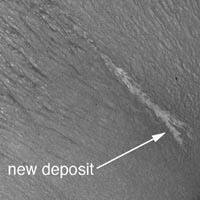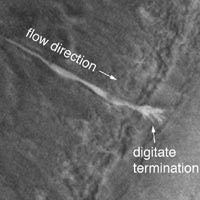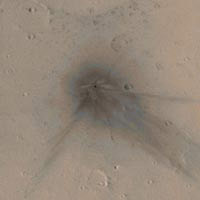Astrobiology
Top 10: Water Flows on Mars
 Summary
Summary (Jan 07,
2007): Astrobiology Magazine is looking back over 2006,
highlighting the Top 10 astrobiology stories of the year. The
number 1 story is the discovery of possible water flows on the
surface of Mars within the past seven years. The new finding
increases the potential for microbial life on Mars.
(This
article originally appeared on December 7,
2006.)Display Options:
















Water Flows Today on Mars
based on a NASA/JPL
release
 |
New gully deposit in a
crater in the Centauri Montes Region.
Image
credit: NASA/JPL-Caltech/Malin Space Science Systems
|
NASA photographs have revealed
bright new deposits seen in two gullies on Mars that suggest
water carried sediment through them sometime during the past
seven years.
"These observations give the strongest
evidence to date that water still flows occasionally on the
surface of Mars," said Dr. Michael Meyer, lead scientist for
NASA's Mars Exploration Program, Washington.
Liquid
water, as opposed to the water ice and water vapor known to
exist at Mars, is considered necessary for
life.
The new findings heighten intrigue about the potential for
microbial life on Mars. The Mars Orbiter Camera on NASA's Mars
Global Surveyor provided the new evidence of the deposits in
images taken in 2004 and 2005.
"The shapes of these
deposits are what you would expect to see if the material were
carried by flowing water," said Dr. Michael Malin of Malin
Space Science Systems, San Diego. "They have finger-like
branches at the downhill end and are easily diverted around
small obstacles." Malin is principal investigator for the
camera and lead author of a report about the findings
published in the journal Science.
The atmosphere of
Mars is so thin and the temperature so cold that liquid water
cannot persist at the surface. It would rapidly evaporate or
freeze. Researchers propose that water could remain liquid
long enough, after breaking out from an underground source, to
carry debris downslope before totally freezing. The two fresh
deposits are each several hundred meters, or yards, long.
 |
Enlarged view of a new
gully deposit in a crater in Terra Sirenum.
Image
credit: NASA/JPL/Malin Space Science Systems
|
The light tone of the deposits
could be from surface frost continuously replenished by ice
within the body of the deposit. Another possibility is a salty
crust, which would be a sign of water's effects in
concentrating the salts. If the deposits had resulted from dry
dust slipping down the slope, they would likely be dark, based
on the dark tones of dust freshly disturbed by rover tracks,
dust devils and fresh craters on Mars.
Mars Global
Surveyor has discovered tens of thousands of gullies on slopes
inside craters and other depressions on Mars. Most gullies are
at latitudes of 30 degrees or higher. Malin and his team first
reported the discovery of the gullies in 2000. To look for
changes that might indicate present-day flow of water, his
camera team repeatedly imaged hundreds of the sites. One pair
of images showed a gully that appeared after mid-2002. That
site was on a sand dune, and the gully-cutting process was
interpreted as a dry flow of sand.
Today's
announcement is the first to reveal newly deposited material
apparently carried by fluids after earlier imaging of the same
gullies. The two sites are inside craters in the Terra Sirenum
and the Centauri Montes regions of southern Mars.
"These fresh deposits suggest that at some places and
times on present-day Mars, liquid water is emerging from
beneath the ground and briefly flowing down the slopes. This
possibility raises questions about how the water would stay
melted below ground, how widespread it might be, and whether
there's a below-ground wet habitat conducive to life. Future
missions may provide the answers," said Malin.
 |
Colorized view of new
impact crater.
Image credit: NASA/JPL/Malin Space
Science Systems |
Besides
looking for changes in gullies, the orbiter's camera team
assessed the rate at which new impact craters appear. The
camera photographed approximately 98 percent of Mars in 1999
and approximately 30 percent of the planet was photographed
again in 2006. The newer images show 20 fresh impact craters,
ranging in diameter from 2 meters (7 feet) to 148 meters (486
feet) that were not present approximately seven years earlier.
These results have important implications for determining the
ages of features on the surface of Mars. These results also
approximately match predictions and imply that Martian terrain
with few craters is truly young.
Mars Global Surveyor
began orbiting Mars in 1997. The spacecraft is responsible for
many important discoveries. NASA has not heard from the
spacecraft since early November. Attempts to contact it
continue. Its unprecedented longevity has allowed monitoring
Mars for over several years past its projected lifetime.
Related Web Pages
NPR
report of findingMGS
Over and Out?Chemistry
Says... Mars Not so Wet One
for the Water Side? CRISM
Opens its EyesWater
is in the DetailsNote:
Mars Life
Display Options:















Sunday, January 07, 2007

